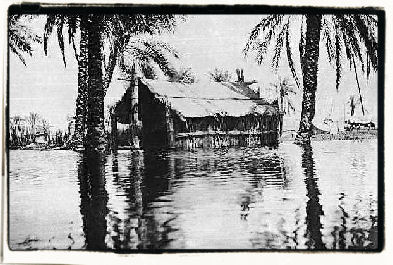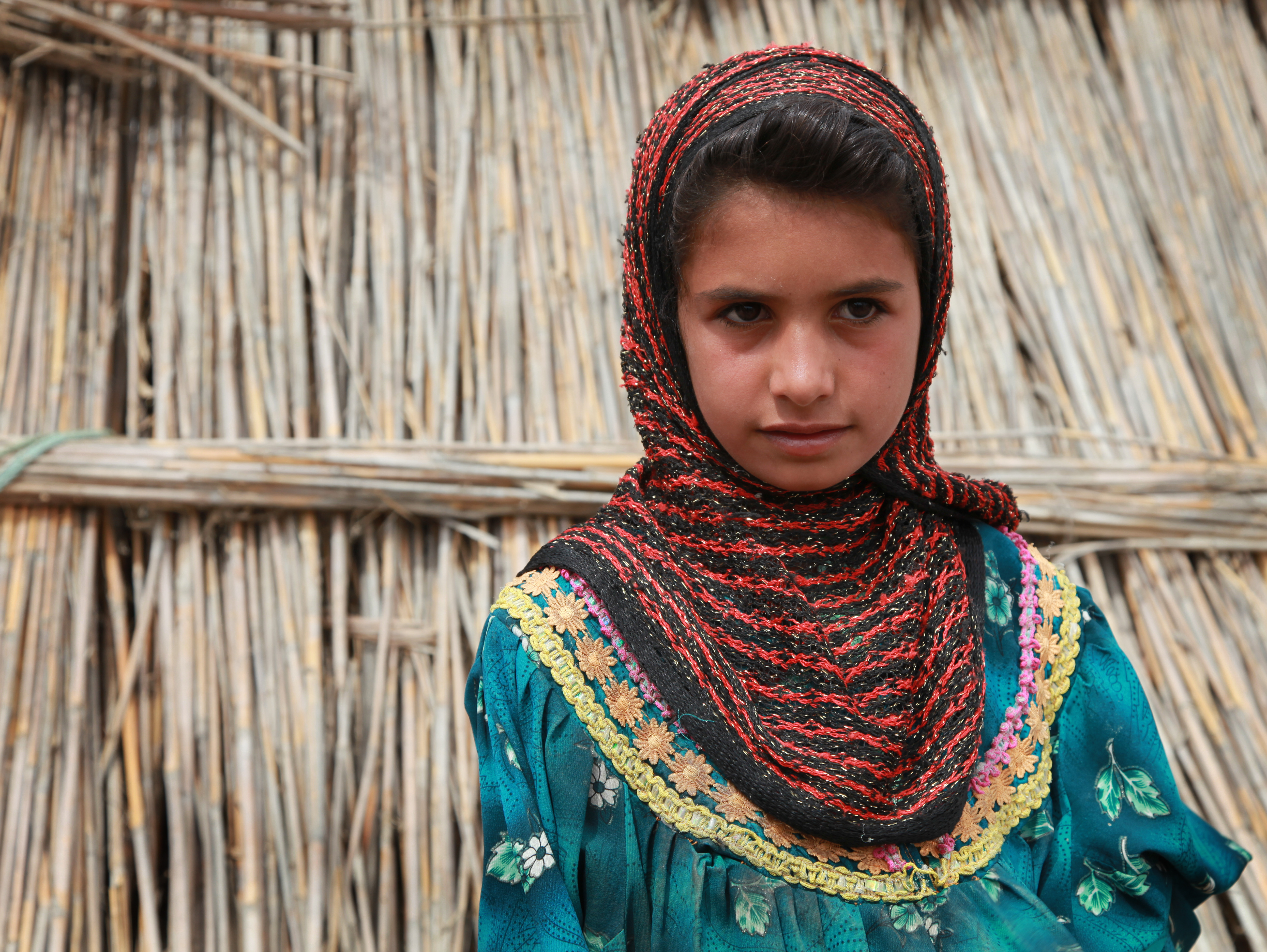Mudhif on:
[Wikipedia]
[Google]
[Amazon]

 A Mudhif ( ar, المضيف ''al-muḍīf'') is a traditional
A Mudhif ( ar, المضيف ''al-muḍīf'') is a traditional
 A mudhif is a special type of ''sarifa''; a structure made from reeds which grow naturally in the marshlands and is used by the village sheik as a guest-house. Other types of reed dwelling, such as a ''raba'' (with entrances at both ends and used as a family dwelling) or a ''bayt'' (strictly a single-room dwelling) are typically smaller than a mudhif and may be used for residential and other purposes.
Each village sheik had a mudhif capable of accommodating at least ten persons. The number of arches used in a mudhif is dictated by the tribe and family group. Sometimes the mudhif was decorated with additional bundles of reeds, arranged in decorative patterns, placed on the façade, to serve as a tribal identifier. The entrance to the mudhif always faces Mecca.
A mudhif is a special type of ''sarifa''; a structure made from reeds which grow naturally in the marshlands and is used by the village sheik as a guest-house. Other types of reed dwelling, such as a ''raba'' (with entrances at both ends and used as a family dwelling) or a ''bayt'' (strictly a single-room dwelling) are typically smaller than a mudhif and may be used for residential and other purposes.
Each village sheik had a mudhif capable of accommodating at least ten persons. The number of arches used in a mudhif is dictated by the tribe and family group. Sometimes the mudhif was decorated with additional bundles of reeds, arranged in decorative patterns, placed on the façade, to serve as a tribal identifier. The entrance to the mudhif always faces Mecca.
 The English writer,
The English writer,
 A mudhif is used as a guest house or for ceremonial occasions, and may not be used for any other purpose. When a guest enters a mudhif, he or she will be welcomed by the village sheik, escorted to their proper place and offered refreshments such as highly sweetened coffee in a ritualised ceremony.
A mudhif is used as a guest house or for ceremonial occasions, and may not be used for any other purpose. When a guest enters a mudhif, he or she will be welcomed by the village sheik, escorted to their proper place and offered refreshments such as highly sweetened coffee in a ritualised ceremony.
Mudhif under construction
and the Marsh Arabs House types Architecture in Iraq Marsh Arabs Vernacular architecture Arab inventions

 A Mudhif ( ar, المضيف ''al-muḍīf'') is a traditional
A Mudhif ( ar, المضيف ''al-muḍīf'') is a traditional reed
Reed or Reeds may refer to:
Science, technology, biology, and medicine
* Reed bird (disambiguation)
* Reed pen, writing implement in use since ancient times
* Reed (plant), one of several tall, grass-like wetland plants of the order Poales
* ...
house made by the Madan people (also known as Marsh Arabs
The Marsh Arabs ( ar, عرب الأهوار ''ʻArab al-Ahwār'' "Arabs of the Marshlands"), also referred to as the Maʻdān ( ar, معدان "dweller in the plains") or Shroog (Iraqi ar, شروق, "those from the east")—the latter two often ...
) in the swamps of southern Iraq
Iraq,; ku, عێراق, translit=Êraq officially the Republic of Iraq, '; ku, کۆماری عێراق, translit=Komarî Êraq is a country in Western Asia. It is bordered by Turkey to Iraq–Turkey border, the north, Iran to Iran–Iraq ...
. In the traditional Madan way of living, houses are constructed from reeds harvested from the marshes where they live. A mudhif is a large ceremonial house, paid for and maintained by a local sheik, for use by guests or as a gathering place for weddings, funerals, etc.
Description
Mudhif structures have been one of the traditional types of structures, built by the Arabs of the marshlands in southern Iraq for at least 5,000 years. A carved elevation of a typical mudhif, dating to around 3,300 BCE was discovered atUruk
Uruk, also known as Warka or Warkah, was an ancient city of Sumer (and later of Babylonia) situated east of the present bed of the Euphrates River on the dried-up ancient channel of the Euphrates east of modern Samawah, Al-Muthannā, Iraq.Harm ...
, and is now in the British Museum
The British Museum is a public museum dedicated to human history, art and culture located in the Bloomsbury area of London. Its permanent collection of eight million works is among the largest and most comprehensive in existence. It docum ...
.
 A mudhif is a special type of ''sarifa''; a structure made from reeds which grow naturally in the marshlands and is used by the village sheik as a guest-house. Other types of reed dwelling, such as a ''raba'' (with entrances at both ends and used as a family dwelling) or a ''bayt'' (strictly a single-room dwelling) are typically smaller than a mudhif and may be used for residential and other purposes.
Each village sheik had a mudhif capable of accommodating at least ten persons. The number of arches used in a mudhif is dictated by the tribe and family group. Sometimes the mudhif was decorated with additional bundles of reeds, arranged in decorative patterns, placed on the façade, to serve as a tribal identifier. The entrance to the mudhif always faces Mecca.
A mudhif is a special type of ''sarifa''; a structure made from reeds which grow naturally in the marshlands and is used by the village sheik as a guest-house. Other types of reed dwelling, such as a ''raba'' (with entrances at both ends and used as a family dwelling) or a ''bayt'' (strictly a single-room dwelling) are typically smaller than a mudhif and may be used for residential and other purposes.
Each village sheik had a mudhif capable of accommodating at least ten persons. The number of arches used in a mudhif is dictated by the tribe and family group. Sometimes the mudhif was decorated with additional bundles of reeds, arranged in decorative patterns, placed on the façade, to serve as a tribal identifier. The entrance to the mudhif always faces Mecca.
 The English writer,
The English writer, Gertrude Bell
Gertrude Margaret Lowthian Bell, CBE (14 July 1868 – 12 July 1926) was an English writer, traveller, political officer, administrator, and archaeologist. She spent much of her life exploring and mapping the Middle East, and became highly ...
, wrote a description of a mudhif in a letter to her father:
Construction
In the construction of a mudhif, reeds are bundled and woven into thick columns; larger and thicker reeds are bent across and tied to form parabolic arches which make up the building's spine. These arches are strengthened by the pre-stressing of the columns, as they are initially inserted into the soil at opposing angles. A series of arches define the building's form. Long cross beams of smaller bundled reeds are laid across the arches and tied. Woven mats of reeds form the building envelope. Some of the mats are woven with perforations like a mesh to allow light and ventilation. The front and back walls are attached to two large vertical bundled reed columns and are also made from woven mats. Mudhif need to be rebuilt every ten years.Reeds as a construction material
The most common type of reed used for the construction of marshland mudhif is ''ihdri.'' Reed has properties which make it an ideal building material - it has a high concentration of silica which makes it water resistant, unattractive for insects and other pests and an excellent thermal and acoustic insulating material. It is an inexpensive material and it is both flexible and durable as a construction material, which encourages creativity.Use
 A mudhif is used as a guest house or for ceremonial occasions, and may not be used for any other purpose. When a guest enters a mudhif, he or she will be welcomed by the village sheik, escorted to their proper place and offered refreshments such as highly sweetened coffee in a ritualised ceremony.
A mudhif is used as a guest house or for ceremonial occasions, and may not be used for any other purpose. When a guest enters a mudhif, he or she will be welcomed by the village sheik, escorted to their proper place and offered refreshments such as highly sweetened coffee in a ritualised ceremony.
Recent developments
In the 1980s, some half a million Arabs lived in the marshes. However, from around 1993,Saddam Hussein
Saddam Hussein ( ; ar, صدام حسين, Ṣaddām Ḥusayn; 28 April 1937 – 30 December 2006) was an Iraqi politician who served as the fifth president of Iraq from 16 July 1979 until 9 April 2003. A leading member of the revolution ...
began to drain the marshes in an attempt to destroy the life and culture of the southern Arabs. Following Hussein's defeat in 2003, Arab communities began to dig up the dykes, re-flooding the marshes and resuming their traditional way of life.
See also
* Culture of Iraq * Draining of the Mesopotamian Marshes *Iraqi art
Iraqi art is one of the richest art heritages in world and refers to all works of visual art originating from the geographical region of what is present day Iraq since ancient Mesopotamian periods. For centuries, the capital, Baghdad was the Med ...
* Vernacular architecture
Vernacular architecture is building done outside any academic tradition, and without professional guidance. This category encompasses a wide range and variety of building types, with differing methods of construction, from around the world, bo ...
References
External links
{{Commonscat, MudhifMudhif under construction
and the Marsh Arabs House types Architecture in Iraq Marsh Arabs Vernacular architecture Arab inventions